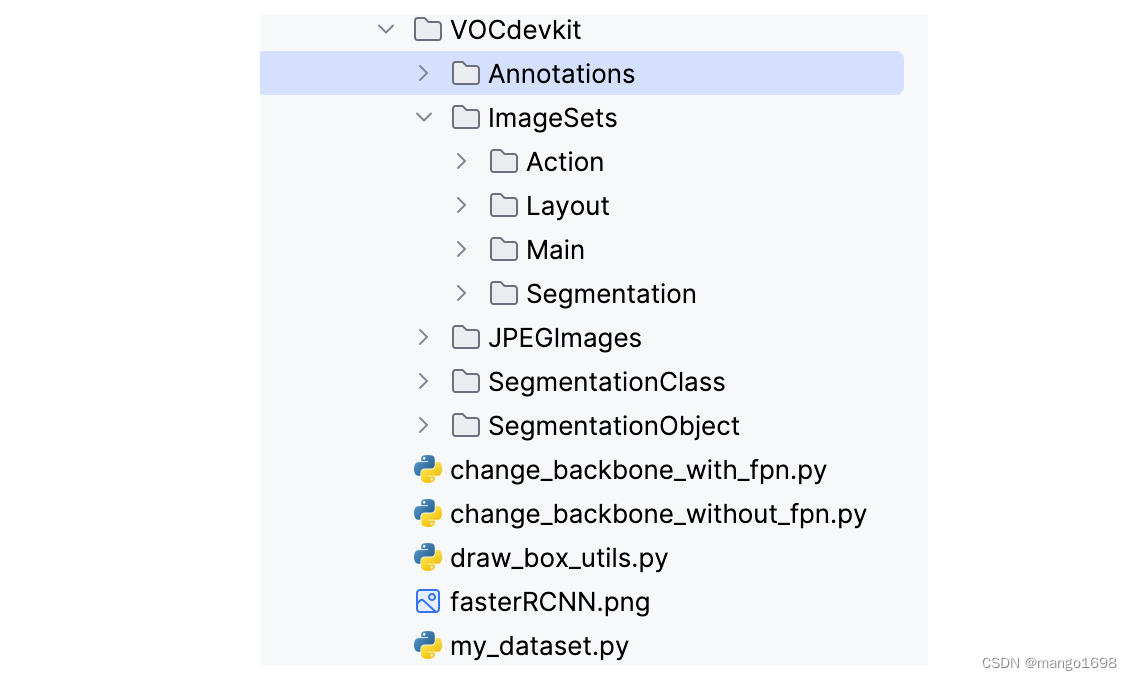自定义数据集 - Dataset
1. PASCAL VOC格式 划分训练集和验证集
import os
import random
def main():
random.seed(0) # 设置随机种子,保证随机结果可复现
files_path = "./VOCdevkit/VOC2012/Annotations" # 指定annotations目录
assert os.path.exists(files_path), "path: '{}' does not exist.".format(files_path)
val_rate = 0.5 # 定义划分比例
files_name = sorted([file.split(".")[0] for file in os.listdir(files_path)])
files_num = len(files_name)
val_index = random.sample(range(0, files_num), k=int(files_num*val_rate))
train_files = []
val_files = []
for index, file_name in enumerate(files_name):
if index in val_index:
val_files.append(file_name)
else:
train_files.append(file_name)
try:
train_f = open("train.txt", "x")
eval_f = open("val.txt", "x")
train_f.write("\n".join(train_files))
eval_f.write("\n".join(val_files))
except FileExistsError as e:
print(e)
exit(1)
if __name__ == '__main__':
main()
2. 自定义dataset
自定义自己的数据集,需要继承torch.utils.data.Dataset,并且实现__len__和__getitem__方法。
__len__:获取数据集的大小__getitem__:返回数据信息
如果使用多GPU训练,还需要实现get_height_and_width方法,获取图像的高度和宽度,如果不实现这个方法,它就会载入所有的图片,去计算图片的高和宽,这样的话就比较耗时和占内存。

from torch.utils.data import Dataset
import os
import torch
import json
from PIL import Image
from lxml import etree
# 继承torch.utils.data.Dataset
class VOCDataSet(Dataset):
"""读取解析PASCAL VOC2007/2012数据集"""
"""
voc_root:数据集所在根目录
year:数据集年份
transforms:数据预处理方法
text_name:读取txt文件名称 train.txt/val.txt
"""
def __init__(self, voc_root, year="2012", transforms=None, txt_name: str = "train.txt"):
assert year in ["2007", "2012"], "year must be in ['2007', '2012']"
# 增加容错能力
if "VOCdevkit" in voc_root:
self.root = os.path.join(voc_root, f"VOC{year}")
else:
self.root = os.path.join(voc_root, "VOCdevkit", f"VOC{year}")
self.img_root = os.path.join(self.root, "JPEGImages")
self.annotations_root = os.path.join(self.root, "Annotations")
# 读取 train.txt 或 val.txt文件
txt_path = os.path.join(self.root, "ImageSets", "Main", txt_name)
assert os.path.exists(txt_path), "not found {} file.".format(txt_name)
with open(txt_path) as read:
# strip() 方法用于移除字符串头尾指定的字符
xml_list = [os.path.join(self.annotations_root, line.strip() + ".xml")
for line in read.readlines() if len(line.strip()) > 0]
self.xml_list = []
# 确认文件是否存在
for xml_path in xml_list:
if os.path.exists(xml_path) is False:
print(f"Warning: not found '{xml_path}', skip this annotation file.")
continue
# 排除图像中没有目标的数据
with open(xml_path) as fid:
xml_str = fid.read()
xml = etree.fromstring(xml_str)
data = self.parse_xml_to_dict(xml)["annotation"]
if "object" not in data:
print(f"INFO: no objects in {xml_path}, skip this annotation file.")
continue
self.xml_list.append(xml_path)
assert len(self.xml_list) > 0, "in '{}' file does not find any information.".format(txt_path)
# 读取数据集类别信息
json_file = './pascal_voc_classes.json'
assert os.path.exists(json_file), "{} file not exist.".format(json_file)
with open(json_file, 'r') as f:
self.class_dict = json.load(f)
self.transforms = transforms
# 获取数据集大小
def __len__(self):
return len(self.xml_list)
# 根据传入的索引值获取数据信息
def __getitem__(self, idx):
# 读取xml文件
xml_path = self.xml_list[idx]
with open(xml_path) as fid:
xml_str = fid.read()
xml = etree.fromstring(xml_str)
data = self.parse_xml_to_dict(xml)["annotation"]
img_path = os.path.join(self.img_root, data["filename"])
image = Image.open(img_path)
if image.format != "JPEG":
raise ValueError("Image '{}' format not JPEG".format(img_path))
boxes = []
labels = []
iscrowd = []
assert "object" in data, "{} lack of object information.".format(xml_path)
for obj in data["object"]:
xmin = float(obj["bndbox"]["xmin"])
xmax = float(obj["bndbox"]["xmax"])
ymin = float(obj["bndbox"]["ymin"])
ymax = float(obj["bndbox"]["ymax"])
# 进一步检查数据,有的标注信息中可能有w或h为0的情况,这样的数据会导致计算回归loss为nan
if xmax <= xmin or ymax <= ymin:
print("Warning: in '{}' xml, there are some bbox w/h <=0".format(xml_path))
continue
boxes.append([xmin, ymin, xmax, ymax])
labels.append(self.class_dict[obj["name"]])
if "difficult" in obj:
iscrowd.append(int(obj["difficult"]))
else:
iscrowd.append(0)
# 将数据转为tensor类型
boxes = torch.as_tensor(boxes, dtype=torch.float32)
labels = torch.as_tensor(labels, dtype=torch.int64)
iscrowd = torch.as_tensor(iscrowd, dtype=torch.int64)
image_id = torch.tensor([idx])
area = (boxes[:, 3] - boxes[:, 1]) * (boxes[:, 2] - boxes[:, 0])
target = {}
target["boxes"] = boxes
target["labels"] = labels
target["image_id"] = image_id
target["area"] = area
target["iscrowd"] = iscrowd
if self.transforms is not None:
image, target = self.transforms(image, target)
return image, target
# 获取图像高度和宽度
def get_height_and_width(self, idx):
# read xml
xml_path = self.xml_list[idx]
with open(xml_path) as fid:
xml_str = fid.read()
xml = etree.fromstring(xml_str)
data = self.parse_xml_to_dict(xml)["annotation"]
data_height = int(data["size"]["height"])
data_width = int(data["size"]["width"])
return data_height, data_width
"""
将xml文件解析成字典形式
"""
def parse_xml_to_dict(self, xml):
if len(xml) == 0: # 遍历到底层,直接返回tag对应的信息
return {xml.tag: xml.text}
result = {}
for child in xml:
child_result = self.parse_xml_to_dict(child) # 递归遍历标签信息
if child.tag != 'object':
result[child.tag] = child_result[child.tag]
else:
if child.tag not in result: # 因为object可能有多个,所以需要放入列表里
result[child.tag] = []
result[child.tag].append(child_result[child.tag])
return {xml.tag: result}
def coco_index(self, idx):
"""
该方法是专门为pycocotools统计标签信息准备,不对图像和标签作任何处理
由于不用去读取图片,可大幅缩减统计时间
Args:
idx: 输入需要获取图像的索引
"""
# read xml
xml_path = self.xml_list[idx]
with open(xml_path) as fid:
xml_str = fid.read()
xml = etree.fromstring(xml_str)
data = self.parse_xml_to_dict(xml)["annotation"]
data_height = int(data["size"]["height"])
data_width = int(data["size"]["width"])
# img_path = os.path.join(self.img_root, data["filename"])
# image = Image.open(img_path)
# if image.format != "JPEG":
# raise ValueError("Image format not JPEG")
boxes = []
labels = []
iscrowd = []
for obj in data["object"]:
xmin = float(obj["bndbox"]["xmin"])
xmax = float(obj["bndbox"]["xmax"])
ymin = float(obj["bndbox"]["ymin"])
ymax = float(obj["bndbox"]["ymax"])
boxes.append([xmin, ymin, xmax, ymax])
labels.append(self.class_dict[obj["name"]])
iscrowd.append(int(obj["difficult"]))
# convert everything into a torch.Tensor
boxes = torch.as_tensor(boxes, dtype=torch.float32)
labels = torch.as_tensor(labels, dtype=torch.int64)
iscrowd = torch.as_tensor(iscrowd, dtype=torch.int64)
image_id = torch.tensor([idx])
area = (boxes[:, 3] - boxes[:, 1]) * (boxes[:, 2] - boxes[:, 0])
target = {}
target["boxes"] = boxes
target["labels"] = labels
target["image_id"] = image_id
target["area"] = area
target["iscrowd"] = iscrowd
return (data_height, data_width), target
@staticmethod
def collate_fn(batch):
return tuple(zip(*batch))
注意:在进行数据预处理的时候,与进行图像分类数据预处理操作有些不同,如进行图像的翻转时,bbox的坐标信息也应该随之进行改变。

所以,我们自己定义了一个transform.py
import random
from torchvision.transforms import functional as F
class Compose(object):
"""组合多个transform函数"""
def __init__(self, transforms):
self.transforms = transforms
def __call__(self, image, target):
for t in self.transforms:
image, target = t(image, target)
return image, target
class ToTensor(object):
"""将PIL图像转为Tensor"""
def __call__(self, image, target):
image = F.to_tensor(image)
return image, target
class RandomHorizontalFlip(object):
"""随机水平翻转图像以及bboxes"""
def __init__(self, prob=0.5):
self.prob = prob
def __call__(self, image, target):
if random.random() < self.prob:
height, width = image.shape[-2:]
image = image.flip(-1) # 水平翻转图片
bbox = target["boxes"]
# bbox: xmin, ymin, xmax, ymax
bbox[:, [0, 2]] = width - bbox[:, [2, 0]] # 翻转对应bbox坐标信息
target["boxes"] = bbox
return image, target



